The ocean supports the livelihood of over three billion people and provides the main protein source for one billion people worldwide. Marine heatwaves negatively impact this complex ecosystem, causing devastating effects to marine life and our society. Due to climate change, marine heatwaves are becoming more frequent, more intense, and longer lasting.
What is a marine heatwave?
Heatwaves, or periods of unusually warm temperatures, occur not just on land, but also in the ocean. Unlike heatwaves on land, marine heatwaves can persist for many weeks or months. They extend over much larger areas and may warm the ocean to depths of hundreds of metres.
As climate change causes our planet to warm, marine heatwaves are becoming more frequent, more intense, and longer lasting. In fact, the number of marine heatwaves has doubled since 1982 and most recently we have seen extreme events in the North Atlantic, Antarctica, and around the Mediterranean.
Why care about marine heatwaves?
The ocean supports the livelihood of over three billion people and provides the main protein source for one billion people. Marine heatwaves can (and increasingly do) negatively impact this complex ecosystem by causing coral bleaching, harmful algal blooms, kelp and seagrass dieback, disease and mortality in invertebrates, and location shifts in fish species. The knock-on effects have caused economic losses in the order of millions to billions in GBP.
The impacts of marine heatwaves are not confined to the ocean itself, they can also affect our weather. They can fuel powerful tropical cyclones, called hurricanes in the North Atlantic. They have also been associated with heavy precipitation, a result of warm ocean temperatures favouring strong evaporation, which increases the probability of strong rainfall events over land.
Heatwaves have devastating impacts on marine life and our society; it is critical we understand the science behind them.
What causes a marine heatwave?
Marine heatwaves are caused by a range of ocean processes, acting either separately or in combination, but there are two main drivers:
- Surface heat flux: heating from the atmosphere, which tends to occur when an atmospheric high-pressure system sits above a region of water for an extended period.
- Advection: movement of warmer waters into the region by ocean currents.
Marine heatwaves driven by surface heat flux tend to be shallower and shorter in duration, whereas as those driven by advection can be deeper and longer in duration. Oceanic mixing processes play a key role in their occurrence, intensity, and persistence.

How do we know they’re happening and changing?
Every day since the early 1980s, satellites have been monitoring sea surface temperatures allowing researchers to study marine heatwaves from space.
Back down on planet Earth, the measurements are taken by instruments on board ships and on permanent ocean observatories. There are also global networks of autonomous robots and floating instruments continuously collecting ocean data throughout the water column.
The general increase in marine heatwave frequency, intensity, and duration has been witnessed in all these observing systems. The increasing mean global temperature is one of the main drivers, but changing current systems are also responsible.
Studies
NOC advances research into marine heatwaves to ultimately protect people and economic infrastructure from these marine-related disasters. This includes studies on the causes, variability, ecological and climate impacts of marine heat waves. One important question is on the predictability of marine heatwaves: if we can forecast when and where they might occur, marine industries can make decisions to adapt and mitigate their impacts.
Facilities
NOC enables sustained ocean observations through the maintenance of facilities including the Porcupine Abyssal Plain Sustained Observatory (PAP) and the ARGO network.
PAP is a fixed-point open-ocean observatory located at 4,850m depth in the Northeast Atlantic that has been operated since 1985. It is used to monitor long-term changes throughout the water column, including marine heatwaves such as the one in June 2023 and their effects on the local ecology.
ARGO is a global array of robotic instruments that drift with the ocean currents and take 100,000 observations of ocean temperature and salinity each year. NOC researchers and engineers recently deployed the first of the UK’s new fleet of Biogeochemical (BGC) Argo profiling floats from RRS Discovery. NOC’s British Oceanographic Data Centre act as the UK Argo Data Centre, storing, processing, and enabling sharing throughout the marine community.
In addition to maintaining long-term ocean observatories, scientists at NOC develop innovative, state-of-the-art models and use these tools to better understand and predict marine heat waves. Alongside observational facilities, these models help to address fundamental societal challenges, including marine heat waves.
Dive deeper
Dr Jules Kajtar discusses Why are we experiencing marine heatwaves and How Do We Tackle Them? This video is part of the ‘Into the Blue Podcast’ series.
** Add page to config of the ‘It’s time to turn the tide – donations’ block **
It’s time to turn the tide. Will you help our ocean thrive?
Knowledge is power. Without the knowledge, we lack the power to make change.
By deepening understanding and sharing knowledge of our ocean, we create opportunities for people to play a part in shaping a healthy future for it.
Will you be part of an Ocean Alliance, working to build a world where everyone feels empowered to make the change we need for a thriving ocean?
